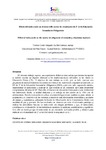El efecto del taekwondo en el desarrollo motor de estudiantes de 2.º de la Educación Secundaria Obligatoria

Use this link to cite
http://hdl.handle.net/2183/23231
Except where otherwise noted, this item's license is described as Atribución-NoComercial-SinDerivadas 3.0 España
Collections
Metadata
Show full item recordTitle
El efecto del taekwondo en el desarrollo motor de estudiantes de 2.º de la Educación Secundaria ObligatoriaAlternative Title(s)
Differences in the levels of agility and BMI in the students of rural and non-rural centers in physical educationDate
2019Citation
Gaintza, Z., & Castro, V. (2019). El efecto del taekwondo en el desarrollo motor de estudiantes de 2.º de la Educación Secundaria Obligatoria. Sportis. Scientific Journal of School Sport, Physical Education and Psychomotricity, 5(2), 270-286. https://doi.org/10.17979/sportis.2019.5.2.4972
Abstract
[Resumen] El presente trabajo expone una experiencia didáctica innovadora que intenta incorporar al ámbito escolar un deporte diferente a los tradicionalmente utilizados en las clases de Educación Física (EF). El objetivo de este trabajo es doble, por un lado, realizar una propuesta de unidad didáctica con contenidos básicos del taekwondo adaptados al currículo de EF de 2º de la Educación Secundaria Obligatoria (ESO) y por otro lado, superando miedos, implementar el taekwondo y analizar en qué medida es un contenido apto para desarrollar competencias del área de EF. Para ello, el docente de educación física junto a una profesional del taekwondo diseña la unidad didáctica y se trabaja en dos cursos de la ESO con 42 adolescentes. Para la evaluación se utiliza una metodología mixta: cualitativa, para valorar la aceptación y el desarrollo de las sesiones, a través de una observación sistemática y un diario de campo, y cuantitativa, utilizando la Escala de Observación de la Competencia Motriz con medidas de pre y pos-test. En los resultados se observa que todo el alumnado participa y realiza las actividades básicas de taekwondo sin ningún problema y que, el taekwondo, contribuye en el desarrollo de las habilidades motrices de agilidad, coordinación y equilibrio. Con ello se concluye que el taekwondo es un contenido curricular posible y efectivo para trabajar con el alumnado de 2º de la ESO desde la asignatura de EF. [Abstract] This paper describes an innovative teaching experiment that attempts to bring into the school setting a sport different from those traditionally used in Physical Education (PE) classes. This paper has twin aims: on the one hand, to outline a proposed teaching unit containing basic taekwondo suited to the PE curriculum for the 2nd year of lower secondary education (ESO), and on the other to overcome fears, implement this combat sport and assess to what extent it is suitable content for developing skills in the area of PE. To this end, the PE teacher together with a taekwondo professional designed the teaching unit, which was put into practice with 42 teenagers in 2nd ESO. A mixed methodology was used to assess it: qualitative - to evaluate the acceptance and progress of the sessions systematic field observation was conducted, and quantitative - to assess motor development, the Motor Skills Rating Scale was used, with pre and post test measurements. In the results it was observed that all pupils took part and performed the basic taekwondo activities with no problem, and that taekwondo helped to develop the motor skills of agility, coordination and balance. It was therefore concluded that taekwondo is a possible, effective curriculum content for working with 2nd ESO pupils in PE classes.
Keywords
Deportes de combate
Taekwondo
Educación secundaria
Innovación
Educación física
Combat sports
Secondary education
Innovation
Physical education
Taekwondo
Educación secundaria
Innovación
Educación física
Combat sports
Secondary education
Innovation
Physical education
Editor version
Rights
Atribución-NoComercial-SinDerivadas 3.0 España
ISSN
2386-8333






